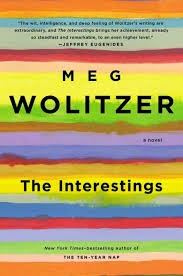Beautiful Ruins by Jess Walter
 Travel to Italy for this one. Its about a young man who runs a small hotel on a tiny island town in Italy. A famous film star comes to stay and sets the story in motion. The author takes us back and forth between the original (1960's) visit and the present day as we find out about the visit and its consequences. For all you artists, there's a wonderful set of paintings in a grotto that makes an appearance. Magical. Liked this one far better than I expected to.
Travel to Italy for this one. Its about a young man who runs a small hotel on a tiny island town in Italy. A famous film star comes to stay and sets the story in motion. The author takes us back and forth between the original (1960's) visit and the present day as we find out about the visit and its consequences. For all you artists, there's a wonderful set of paintings in a grotto that makes an appearance. Magical. Liked this one far better than I expected to.  Bad Monkey by Carl Hiaasen
Bad Monkey by Carl HiaasenYou can't pass a Hiaasen book by without a quick read. His books are always fun and silly and well told. This one doesn't disappoint. Strange characters, a pet monkey, a severed leg and a fishing boat. What more can you ask for. Also makes a great gift book because Hiaasen's characters are so approachable. Everyone likes a good laugh.
A Tale for the Time Being by Ruth Ozecki
 I wasn't sure what to expect from Ozecki this time. I read one of her books years ago and liked it. Her's are always great stories that usually take on a world problem or societal issue. The one I read was about the meat industry. This one was not so cut and dried. This, her newest, was written up in a book magazine I subscribe to. It is a thoughtful and sometimes jarring look at Japan teen culture and the after affects of War. An American writer living off the coast of Washington, finds a plastic bag with a box of childhood mementos, a WWII kamikaze watch and a diary in it. She thinks its trash that has made its way to America from Japan after the tsunami. We follow her journey to find out about the girl, while reading the teenager's diary and learning of her troubling and difficult life in Japan.
I wasn't sure what to expect from Ozecki this time. I read one of her books years ago and liked it. Her's are always great stories that usually take on a world problem or societal issue. The one I read was about the meat industry. This one was not so cut and dried. This, her newest, was written up in a book magazine I subscribe to. It is a thoughtful and sometimes jarring look at Japan teen culture and the after affects of War. An American writer living off the coast of Washington, finds a plastic bag with a box of childhood mementos, a WWII kamikaze watch and a diary in it. She thinks its trash that has made its way to America from Japan after the tsunami. We follow her journey to find out about the girl, while reading the teenager's diary and learning of her troubling and difficult life in Japan. The Interestings by Meg Worlitzer
The Interestings by Meg WorlitzerI absolutely loved this book. I was sorry that it had to end. In the 1970's a group of teenagers meet at a summer camp for artistically gifted kids and become fast friends when they thought it not possible to do so. We follow their lives through college, marriage and kids through to their fifties with all the twists and turns of relationships and success. Its a magical book that, as a child of that era I could definitely relate to. Everyone who became teenagers in the 70's, graduated college in the 80's and is in their fifties now should check this one out.
Where'd You Go Bernadette? by Maria Semple
 Here's a quirky one. I thought this was going to be a little light and fluffy, but in fact it was so not the case. Bernadette lives in Seattle. Her husband is a Microsoft wunderkind and her daughter, a gifted 7th grader. As a reward to her daughter, the family decides to take a trip to Antarctica, a place her daughter has asked to visit. Bernadette is a funky, anti-establishment mom who disappears on the ship. I loved her character and could totally understand and relate to her. Anybody who thinks to outsource the help she needs to organize and run her life to a service in India is cool with me. Funny, quirky, lovable and poignant.
Here's a quirky one. I thought this was going to be a little light and fluffy, but in fact it was so not the case. Bernadette lives in Seattle. Her husband is a Microsoft wunderkind and her daughter, a gifted 7th grader. As a reward to her daughter, the family decides to take a trip to Antarctica, a place her daughter has asked to visit. Bernadette is a funky, anti-establishment mom who disappears on the ship. I loved her character and could totally understand and relate to her. Anybody who thinks to outsource the help she needs to organize and run her life to a service in India is cool with me. Funny, quirky, lovable and poignant.




